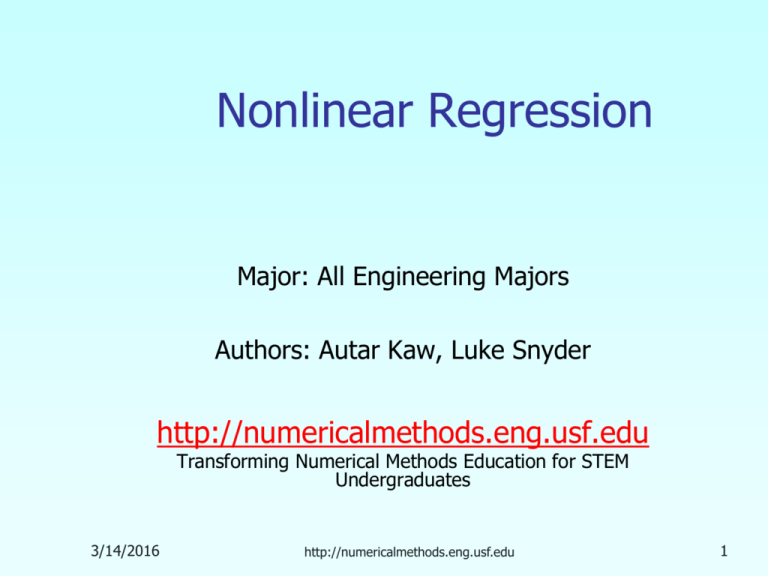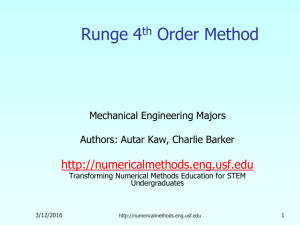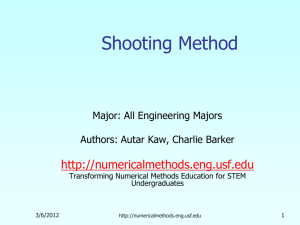Nonlinear Regression
advertisement

Nonlinear Regression Major: All Engineering Majors Authors: Autar Kaw, Luke Snyder http://numericalmethods.eng.usf.edu Transforming Numerical Methods Education for STEM Undergraduates 3/14/2016 http://numericalmethods.eng.usf.edu 1 Nonlinear Regression http://numericalmethods.eng.usf.edu Nonlinear Regression Some popular nonlinear regression models: 1. Exponential model: ( y aebx ) 2. Power model: ( y ax b ) ax y b x 3. Saturation growth model: 4. Polynomial model: 3 ( y a0 a1x ... amx m ) http://numericalmethods.eng.usf.edu Nonlinear Regression Given n data points ( x1, y1), ( x 2, y 2), ... , ( xn, yn ) best fit y f (x ) to the data, where f (x ) is a nonlinear function of x . (x , y ) n n (x , y ) 2 2 y f (x) (x , y ) i ( x1 , y1 ) i y f (x ) i i Figure. Nonlinear regression model for discrete y vs. x data 4 http://numericalmethods.eng.usf.edu Regression Exponential Model 5 http://numericalmethods.eng.usf.edu Exponential Model bx Given ( x1 , y1 ), ( x2 , y 2 ), ... , ( xn , yn ) best fit y ae to the data. ( x1 , y1 ) y aebx (x , y ) i (x , y ) 2 2 yi ae bxi i (x , y ) n n Figure. Exponential model of nonlinear regression for y vs. x data 6 http://numericalmethods.eng.usf.edu Finding Constants of Exponential Model The sum of the square of the residuals is defined as n Sr y ae i 1 i bx 2 i Differentiate with respect to a and b n S r bxi bxi 2 y i ae e 0 a i 1 n S r bxi bxi 2 y i ae axi e 0 b i 1 7 http://numericalmethods.eng.usf.edu Finding Constants of Exponential Model Rewriting the equations, we obtain n yi e bxi i 1 n y i xi e i 1 8 bxi n a e 2bxi 0 i 1 n a xi e i 1 2bxi 0 http://numericalmethods.eng.usf.edu Finding constants of Exponential Model Solving the first equation for a yields n a yi e bxi i 1 n 2bxi e i 1 Substituting a back into the previous equation n n y i xi e i 1 bxi yi e i 1 n bxi 2bxi e n 2bxi x e 0 i i 1 i 1 The constant b can be found through numerical methods such as bisection method. 9 http://numericalmethods.eng.usf.edu Example 1-Exponential Model Many patients get concerned when a test involves injection of a radioactive material. For example for scanning a gallbladder, a few drops of Technetium-99m isotope is used. Half of the Technetium-99m would be gone in about 6 hours. It, however, takes about 24 hours for the radiation levels to reach what we are exposed to in day-to-day activities. Below is given the relative intensity of radiation as a function of time. Table. Relative intensity of radiation as a function of time. t(hrs) 10 0 1 3 5 7 9 1.000 0.891 0.708 0.562 0.447 0.355 http://numericalmethods.eng.usf.edu Example 1-Exponential Model cont. The relative intensity is related to time by the equation t Ae Find: a) The value of the regression constants A and b) The half-life of Technetium-99m c) Radiation intensity after 24 hours 11 http://numericalmethods.eng.usf.edu Plot of data 12 http://numericalmethods.eng.usf.edu Constants of the Model Aet The value of λ is found by solving the nonlinear equation n n f i t i e ti i 1 ti e i i 1 n 2ti e n 2ti t e 0 i i 1 i 1 n A t e i i i 1 n 2 t i e i 1 13 http://numericalmethods.eng.usf.edu Setting up the Equation in MATLAB n n f i t i e i 1 ti ie i 1 n e ti n ti e 2ti i 1 2ti 0 i 1 t (hrs) 0 1 3 5 7 9 γ 1.000 0.891 0.708 0.562 0.447 0.355 14 http://numericalmethods.eng.usf.edu Setting up the Equation in MATLAB n n f i t i e i 1 ti ie i 1 n e ti n 2ti t e 0 i 2ti i 1 i 1 0.1151 t=[0 1 3 5 7 9] gamma=[1 0.891 0.708 0.562 0.447 0.355] syms lamda sum1=sum(gamma.*t.*exp(lamda*t)); sum2=sum(gamma.*exp(lamda*t)); sum3=sum(exp(2*lamda*t)); sum4=sum(t.*exp(2*lamda*t)); f=sum1-sum2/sum3*sum4; 15 http://numericalmethods.eng.usf.edu Calculating the Other Constant The value of A can now be calculated 6 A e i 1 6 ti i 2 ti e 0.9998 i 1 The exponential regression model then is 0.9998 e 16 0.1151t http://numericalmethods.eng.usf.edu Plot of data and regression curve 0.9998 e0.1151t 17 http://numericalmethods.eng.usf.edu Relative Intensity After 24 hrs The relative intensity of radiation after 24 hours 0.9998 e 0.115124 6.3160 10 2 This result implies that only 6.316 102 100 6.317% 0.9998 radioactive intensity is left after 24 hours. 18 http://numericalmethods.eng.usf.edu Homework • • • • 19 What is the half-life of Technetium-99m isotope? Write a program in the language of your choice to find the constants of the model. Compare the constants of this regression model with the one where the data is transformed. t e What if the model was ? http://numericalmethods.eng.usf.edu THE END http://numericalmethods.eng.usf.edu 20 http://numericalmethods.eng.usf.edu Polynomial Model Given best fit y a0 a1 x ... am x ( x1, y1), ( x 2, y 2), ... , ( xn, yn) m (m n 2) to a given data set. (x , y ) n n (x , y ) 2 2 y a a x a xm (x , y ) i ( x1 , y1 ) i 0 1 m y f (x ) i i Figure. Polynomial model for nonlinear regression of y vs. x data 21 http://numericalmethods.eng.usf.edu Polynomial Model cont. The residual at each data point is given by Ei y i a0 a1 xi . . . a m xim The sum of the square of the residuals then is n S r Ei2 i 1 n y i a 0 a1 xi . . . a m xim 2 i 1 22 http://numericalmethods.eng.usf.edu Polynomial Model cont. To find the constants of the polynomial model, we set the derivatives with respect to ai where i 1, m, equal to zero. n S r 2. yi a0 a1 xi . . . am xim (1) 0 a0 i 1 n S r 2. yi a0 a1 xi . . . am xim ( xi ) 0 a1 i 1 n S r 2. yi a0 a1 xi . . . am xim ( xim ) 0 am i 1 23 http://numericalmethods.eng.usf.edu Polynomial Model cont. These equations in matrix form are given by n n xi i 1 . . . n m xi i 1 n xi i 1 n 2 xi i 1 . . . . . . . . . n m1 xi . . i 1 n m . xi a i 1 0 n m1 a1 . xi i 1 . . . . . a m n . xi2 m i 1 n yi ni 1 xi yi . i 1 . . . n xim yi i 1 The above equations are then solved for a0 , a1 ,, am 24 http://numericalmethods.eng.usf.edu Example 2-Polynomial Model Regress the thermal expansion coefficient vs. temperature data to a second order polynomial. 25 Coefficient of thermal expansion, α (in/in/oF) 80 6.47×10−6 40 6.24×10−6 −40 5.72×10−6 −120 5.09×10−6 −200 4.30×10−6 −280 3.33×10−6 −340 2.45×10−6 6.00E-06 5.00E-06 (in/in/o F) Temperature, T (oF) 7.00E-06 Thermal expansion coefficient, α Table. Data points for temperature vs α 4.00E-06 3.00E-06 2.00E-06 -400 -300 -200 1.00E-06 -100 0 100 200 Temperature, o F Figure. Data points for thermal expansion coefficient vs temperature. http://numericalmethods.eng.usf.edu Example 2-Polynomial Model cont. We are to fit the data to the polynomial regression model α a0 a1T a 2T 2 The coefficients a0 ,a1 , a2 are found by differentiating the sum of the square of the residuals with respect to each variable and setting the values equal to zero to obtain n n T i i n1 T 2 i i 1 26 n Ti i 1 n 2 Ti i 1 n 3 Ti i 1 n 2 n Ti i i 1 a i 1 0 n 3 n Ti a1 Ti i i 1 i 1 a n n 4 2 T 2 Ti i i i 1 i 1 http://numericalmethods.eng.usf.edu Example 2-Polynomial Model cont. The necessary summations are as follows Table. Data points for temperature vs. Temperature, T (oF) Coefficient of thermal expansion, α (in/in/oF) α 7 T i 1 T 6.47×10−6 40 6.24×10−6 −40 5.72×10−6 −120 5.09×10−6 i 1 −200 4.30×10−6 7 3.33×10−6 −340 2.45×10−6 2.5580 105 3 7.0472 10 7 4 2.1363 1010 7 80 −280 2 i i 1 i 7 T i i 1 i 7 T i 1 i 7 T i 1 27 3.3600 10 5 i 2 i 2.6978 10 3 i 8.5013 10 1 http://numericalmethods.eng.usf.edu Example 2-Polynomial Model cont. Using these summations, we can now calculate a0 ,a1 , a2 7.0000 2 8.600 10 2.5800 10 5 8.6000 10 2 2.5800 10 5 7.0472 10 7 2.5800 10 5 a 0 3.3600 10 5 7.0472 10 7 a1 2.6978 10 3 2.1363 1010 a 2 8.5013 10 1 Solving the above system of simultaneous linear equations we have 6 a 0 6.0217 10 a 6.2782 10 9 1 11 a 2 1.2218 10 The polynomial regression model is then α a0 a1T a 2T 2 6.0217 10 6 6.2782 10 9 T 1.2218 10 11 T 2 28 http://numericalmethods.eng.usf.edu Transformation of Data To find the constants of many nonlinear models, it results in solving simultaneous nonlinear equations. For mathematical convenience, some of the data for such models can be transformed. For example, the data for an exponential model can be transformed. As shown in the previous example, many chemical and physical processes are governed by the equation, y aebx Taking the natural log of both sides yields, ln y ln a bx Let z ln y and a 0 ln a We now have a linear regression model where z a0 a1 x (implying) 29 a eao with a1 b http://numericalmethods.eng.usf.edu Transformation of data cont. Using linear model regression methods, a1 n n n i 1 i 1 i 1 n xi z i xi z i n xi2 xi i 1 i 1 n _ n 2 _ a 0 z a1 x Once ao , a1 are found, the original constants of the model are found as b a1 a e a0 30 http://numericalmethods.eng.usf.edu THE END http://numericalmethods.eng.usf.edu 31 http://numericalmethods.eng.usf.edu Example 3-Transformation of data Many patients get concerned when a test involves injection of a radioactive material. For example for scanning a gallbladder, a few drops of Technetium99m isotope is used. Half of the Technetium-99m would be gone in about 6 hours. It, however, takes about 24 hours for the radiation levels to reach what we are exposed to in day-to-day activities. Below is given the relative intensity of radiation as a function of time. t(hrs) 0 1 3 5 7 9 1.000 0.891 0.708 0.562 0.447 0.355 1 Relative intensity of radiation, γ Table. Relative intensity of radiation as a function of time 0.5 0 0 5 Time t, (hours) 10 Figure. Data points of relative radiation intensity vs. time 32 http://numericalmethods.eng.usf.edu Example 3-Transformation of data cont. Find: a) The value of the regression constants A and b) The half-life of Technetium-99m c) Radiation intensity after 24 hours The relative intensity is related to time by the equation Aet 33 http://numericalmethods.eng.usf.edu Example 3-Transformation of data cont. Exponential model given as, Ae t ln ln A t Assuming z ln , ao ln A and a1 we obtain z a at 0 1 This is a linear relationship between z and t 34 http://numericalmethods.eng.usf.edu Example 3-Transformation of data cont. Using this linear relationship, we can calculate a0 , a1 where n a n n t z t i 1 i i i 1 n i z i 1 n t 2 t 1 i 1 i 1 i 1 n and n i 2 a0 z a1t a 1 a 0 Ae 35 http://numericalmethods.eng.usf.edu Example 3-Transformation of Data cont. Summations for data transformation are as follows Table. Summation data for Transformation of data model ti i 1 2 3 4 5 6 0 1 3 5 7 9 25.000 i z ln 1 0.891 0.708 0.562 0.447 0.355 0.00000 −0.11541 −0.34531 −0.57625 −0.80520 −1.0356 0.0000 −0.11541 −1.0359 −2.8813 −5.6364 −9.3207 0.0000 1.0000 9.0000 25.000 49.000 81.000 −2.8778 −18.990 165.00 i tz i i i t 2 i With n 6 6 t i 1 6 z i 1 2.8778 i 6 t z i 1 i i 6 t i 1 36 25.000 i 2 i 18.990 165.00 http://numericalmethods.eng.usf.edu Example 3-Transformation of Data cont. Calculating a0 , a1 a1 6 18.990 25 2.8778 2 6165.00 25 0.11505 a0 2.8778 25 0.11505 6 6 2.6150 10 4 Since a0 ln A A e a0 e 2.6150104 0.99974 also a1 0.11505 37 http://numericalmethods.eng.usf.edu Example 3-Transformation of Data cont. 0.11505t Resulting model is 0.99974 e 1 0.99974 e 0.11505t Relative Intensity 0.5 of Radiation, 0 0 5 10 Time, t (hrs) Figure. Relative intensity of radiation as a function of temperature using transformation of data model. 38 http://numericalmethods.eng.usf.edu Example 3-Transformation of Data cont. The regression formula is then 0.99974 e 0.11505t 1 b) Half life of Technetium-99m is when 2 1 0.99974 e 0 .11505t 0.99974 e 0 .115050 2 e 0 .11508t 0.5 0.11505t ln 0.5 t 6.0248 hours 39 t 0 http://numericalmethods.eng.usf.edu Example 3-Transformation of Data cont. c) The relative intensity of radiation after 24 hours is then 0.99974e 0.1150524 0.063200 6.3200 10 2 100 6.3216% of the radioactive This implies that only 0.99983 material is left after 24 hours. 40 http://numericalmethods.eng.usf.edu Comparison Comparison of exponential model with and without data Transformation: Table. Comparison for exponential model with and without data Transformation. 41 With data Transformation (Example 3) Without data Transformation (Example 1) A 0.99974 0.99983 λ −0.11505 −0.11508 Half-Life (hrs) 6.0248 6.0232 Relative intensity after 24 hrs. 6.3200×10−2 6.3160×10−2 http://numericalmethods.eng.usf.edu Additional Resources For all resources on this topic such as digital audiovisual lectures, primers, textbook chapters, multiple-choice tests, worksheets in MATLAB, MATHEMATICA, MathCad and MAPLE, blogs, related physical problems, please visit http://numericalmethods.eng.usf.edu/topics/nonlinear_r egression.html THE END http://numericalmethods.eng.usf.edu






